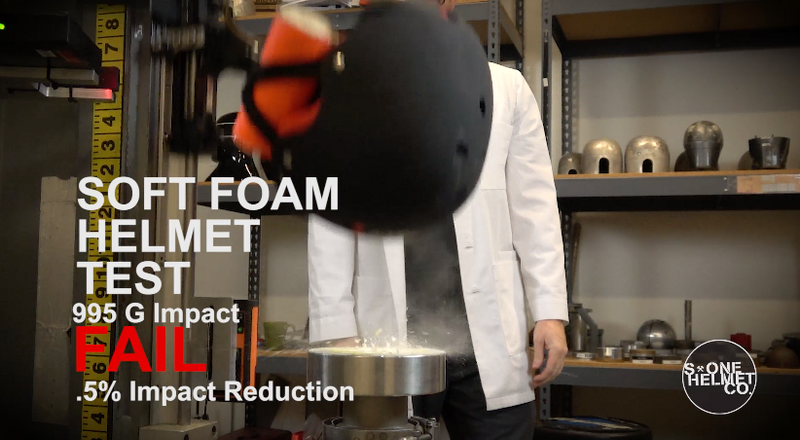Testing Video: S1 Lifer Helmet Vs Soft Foam Helmet

#danfromS1 shows you how helmets are tested and shows you how regular soft foam skate helmets do not adequately buffer or disperse impact energy. This video also explains why the S1 Lifer Helmet is a better and safer helmet.
Impact Testing: S1 Lifer Helmet VS Soft Foam Helmet from S-One Helmet Co | S1 Helmets on Vimeo.
One of the most advanced, scientific and accurate ways to show how much better the S1 Lifer helmet is versus the traditional soft foam skate helmet is to actually test these in an accredited , independent, 3rd party testing facility.
This is the S1 Lifer Helmet which is constructed with our patented blend of EPS Fusion Foam this is a traditional soft foam skate helmet which is constructed with soft foam inserts.
We’re going to put helmets onto this headform that has an accelerometer in it that measures measures impact energy. The head form is connected to a computer that measures the amount of impact that gets the head in a simulated impact. If the helmet does not have adaquate protection it will fail the test (allows 300 G’s to enter head form) and could possibly cause a serious brain injury (or death).
Without any helmet on the head form if we bring this up to 6.5 feet and drop it down onto the hazard it going to generate 1000 G’s worth of force to the head form .
The reason you wear helmet is to buffer or disperse the amount of impact energy that gets to your head. In order to pass the high impact test the helmet must reduce 1000 G’s worth of energy to under 300 G’s. Anything over 300 G’s fails the test.
We have the soft foam helmet on the head form now we are going to bring it up to six and half feet - drop it from the drop tower and see how it performs.
Soft Foam Helmet allows 995 G's to enter the headform. This helmet fails.
So we have the results here from the soft foam helmet. We had it up at 6.5 feet and dropped it down onto a flat surface which is generating 1000 Gs of energy to the head form this helmet only reduced the energy pulse 5 G’s. It got a peak accretion G of 995
So that means that all of the impact energy going straight through this helmet and getting to the headform. To pass this test you have to get a test under 300 G’s this more than 3x that amount. This helmet fails the high impact test.
We have the S1 Lifer Helmet on the headroom now. We are going to bring it up to 6.5 feet and drop it from the drop tower and see how it performs .
S1 Lifer Helmet allows 235 Gs to enter the headform. This helmet Passes.
So we have the testing results for the S1 Lifer helmet which we dropped from the same distance we dropped the soft foam helmet which generated 1000 G’s worth of energy.
The S1 Lifer Helmet took that 1000 Gs and reduced it to 253 Gs which is a pass for the the high impact test.
Basically what your seeing is that the soft foam helmet is allowing the impact energy to go directly thought the helmet and get to the headform. But the S1 Lifer Helmet with the fusion foam is crushing that energy and dispersing out and reducing it 4x the amount the soft foam helmet did. The S1 Lifer Helmet passes the high impact test.
What we wanted to do today was show you in a scientific manner the difference between how the S1 Lifer helmet and a soft foam helmet absorb impact energy what we found was that the Lifer helmet with fusion foam reduced and absorbed impact energy much more effectively than soft foam helmets.
The S1 Lifer Helmet - a better, safer helmet.
